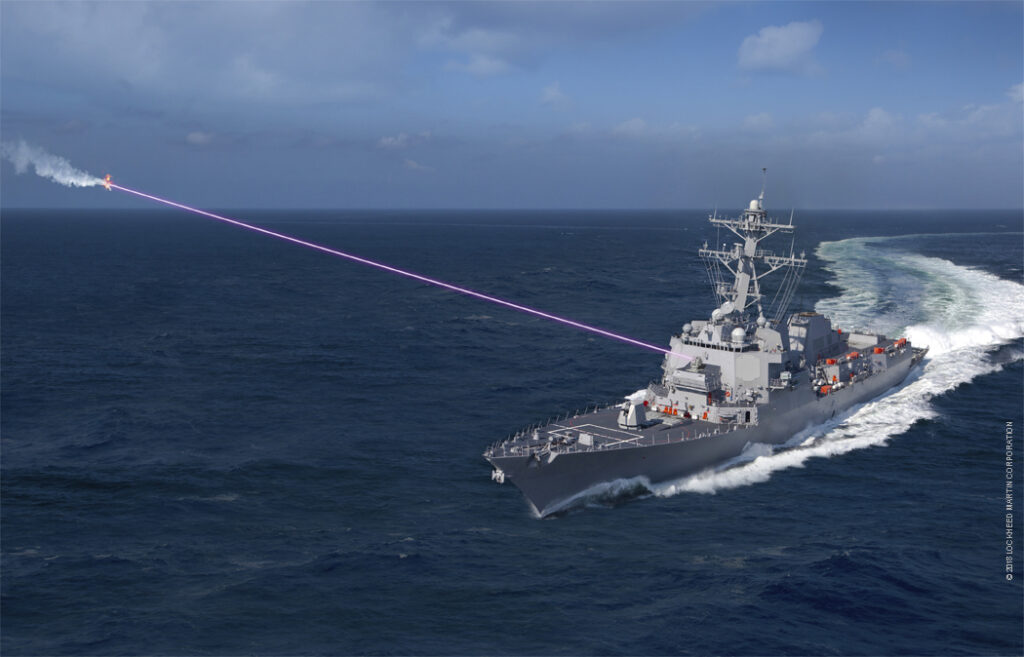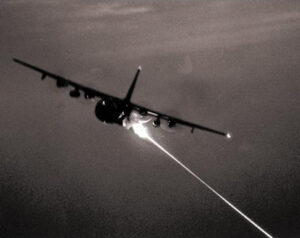Miitary lasers are getting more and more powerful, fast. But raw power isn't all you need for a workable weapon.

Lockheed Martin concept for their HELIOS laser for the Navy
WASHINGTON: Integration of lasers on ships and other weapons is the biggest challenge today— not power. Officers and officials say there are lots of devilish details to deal with before the US military can employ laser weapons on the battlefield, from beam control to targeting to controls you can operate without a PhD.
“I’m not as worried about the power,” said Rear Adm. Ron Boxall, director of surface warfare (N96) on the Navy’s Pentagon staff. “Everyone seems to be on this race to get more and more power, and make no mistake, we’ve got to get more power — but to me the problem I have today is the integration of that [laser] into my existing combat system.”
Navy & SOCOM: Integration
The Navy’s already experimented with a 30-kilowatt laser, LaWS, on the USS Ponce, and this year it will field a “roll-aboard” laser to blind sensors, ODIN, that can go on “anything that’s floating,” Boxall told last week’s Directed Energy Summit. But LaWS and ODIN are stand-alone systems that don’t connect to the combat system that controls a ship’s permanently installed weapons and sensors.
That means, among other things, that the laser doesn’t get targeting data from the ship’s radars and must rely entirely on its own built-in optics. Conversely, the laser’s optics can’t provide targeting data to any other weapon on the ship. And you really want the ships’ other weapons to be able to take advantage of the laser as a sensor: Lasers require extremely high-quality optics to work, and, when not firing, the crew of the Ponce found theirs useful as a super-telescope. In fact, Boxall said, lasers are so precise — both as sensors and as weapons — that they both supply and demand much more data, much faster, than the radar-guided missiles that the Navy’s Aegis fire control system is built around.
Getting lasers and Aegis to work together is a top priority for the Navy’s HELIOSlaser program, which in 2021 will install a 60-kW-plus weapon on an Arleigh Burkedestroyer and — unlike LAWS and ODIN — integrate it with the Aegis combat system. The HELIOS laser will actually replace an existing, proven missile defense weapon, a Phalanx Close-In Weapons System (CIWS) gatling gun.
“I believe that the power will come, I believe that the improvement in beam quality will come,” Boxall said, “but where I’m not yet confident is, very few people are working on that integration.”
While HELIOS will integrate with the Aegis combat system, the admiral said, it still relies on its own dedicated power supply. In the long run, the Navy wants lasers that draw on the ship’s regular electrical system, but modern ships have less and less power to spare as the Navy upgrades their electronics, particularly with the new Air & Missile Defense Radar (AMDR) going on the newest Arleigh Burke destroyers, the Flight III variant. It’ll actually be easier to power a laser on the smaller frigates the Navy is about to buy, said Boxall, because that’ll be a new class whose margin for growth hasn’t yet been eaten up by upgrades. Ultimately, Navy leaders say they want a new cruiser design built for much high power levels.

As Breaking D readers know, Special Operations Command has a similar challenge, but in even tighter quarters: They want a 60-kilowatt weapon on their AC-130 gunships, replacing an existing 30 mm cannon but not impacting the rest of the airplane’s on-board arsenal. That’s the same power as the initial version of the Navy’s HELIOS, but instead of going on a 8,000-10,000 ton warship, it’s going on an aircraft with a maximum takeoff weight of 77 tons.
“It a really challenging math problem in terms of SWAP,” (Size, Weight, And Power) said Lisa Sanders, SOCOM’s science & technology director. The laser will weigh more than the weapon that it replaces — about 8.5 tons counting gun, ammo, mounting, etc. — and the aircraft can take the extra weight,, but the design is tightly constrained, she said.
SOCOM is also working with the Army on a helicopter-mounted laser, Sanders noted, but that’ll be built into a pod and carried externally, rather than tightly integrated into the aircraft itself. Neither laser program has finalized requirements yet.


No comments:
Post a Comment